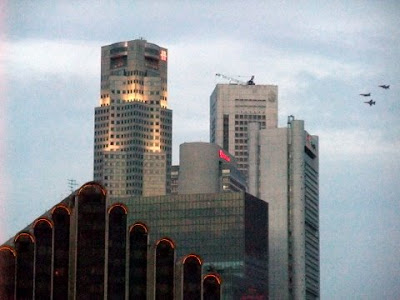On Sunday, 28 June 2009, the Ee Hoe Hean Club with Siong Leng Musical Association (which is just up the hill along the same road) co-sponsored a talk on the journey of the southern sounds - Nan Yin 南音. It is about a music that is more than a thousand years old, and how it travelled from the times of Tang Dynasty to the modern era, about how it manages to remain on course through time and rapid changes, and how it travelled out of China to all corners of the world.
Nan Yin lyrics still maintain the words of the ancient times. The early source of the Hokkien (Minnan) language/dialect, it is a pride of the Hokkiens in Singapore. Interestingly, the interests on this music and song have transcended all dialect groups and even interests people from all over the world.
The elders worry about the Nan Yin becoming extinct. In Quanzhou where it has its base, reports indicate that it is still very strong and thriving well. One could enjoy a performance at any night. One could find many singing the Nan Yin at home, in communities or with friends. In Singapore, there are a number of Nan Yin groups.

Of these groups, Siong Leng Musical Association has been one of the most active in bringing the music and songs to the young, through schools and performances. Each year as it performs in Thian Hock Keng at Telok Ayer St, the courtyard would be filled with the elderly audience waiting in expectations, and even humming along. In recent times, more and more younger ones could be found, some of whom attended out of curiosity, but ended getting stuck with it, a feeling of the residue echoing of the melodies resonating in one's mind, as describe by Ms Zou Lu, one of the two presenters at Ee Hoe Hean Club.
That Siong Leng Musical Association comes this far, with foresight of innovations and creating new songs, one man was instrumental in this, the late Mr. Teng Mah Seng, the previous President of the Association. He has written more than 300 pieces of songs, many of which have now been played in China and other places. He was instrumental in organising ASEAN gathering of Nan Yin groups to perform in Singapore. He led the group to win prices in the Edinburgh Festival.
Ack: Siong Leng Musical Association
At this talk, Mr. Han Shan Yuan, a veteran journalist, also shared his experience both as an interviewer of Mr. Teng and as a friend. Mr Teng did not start his writing of Nan Yin songs till when he was 61 years old when a Nan Yin performance at his mother's funeral wake triggered him. His passion for the music and songs was so great that even when he was diagnosed with cancer, he asked the Almighty to let him have more time so that he could do more. He was a man in a hurry. Said to be a man of little schooling when he came to Singapore to work, many were amazed by the lyrics that he wrote, beautifully composed in classical Chinese.
Mr. Teng must be very proud that today, the descendants of Siong Leng Musical Association continues to perform his songs and music. He has left behind a very important legacy to the Singaporeans, and to the Nan Yin lovers in the world!
A new and young group performs for us the legacy of Mr. Teng.
Ack: Siong Leng Musical Association, Ms Zou Lu, Mr. Han Shan Yuan






